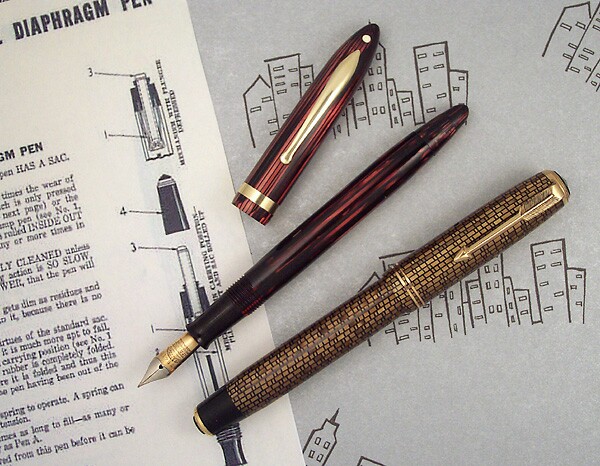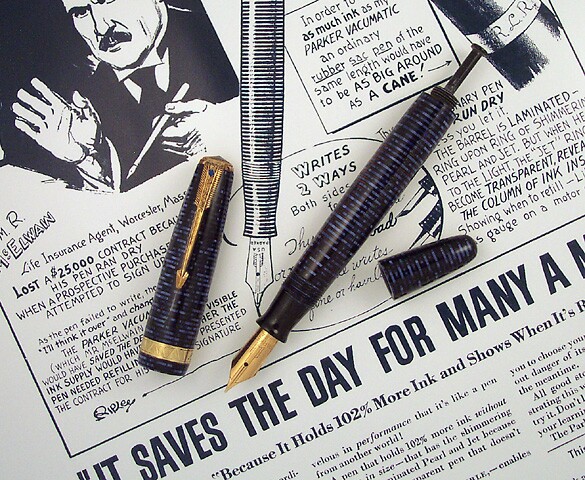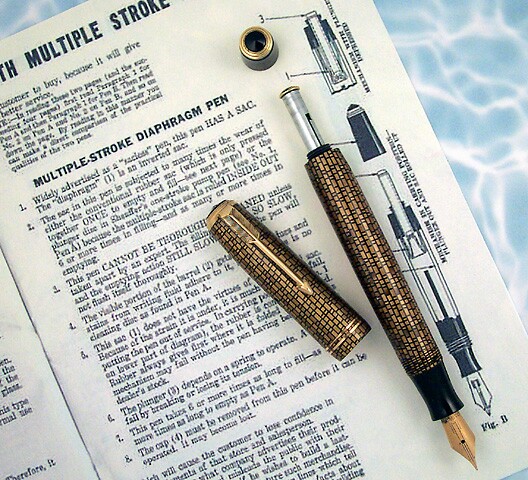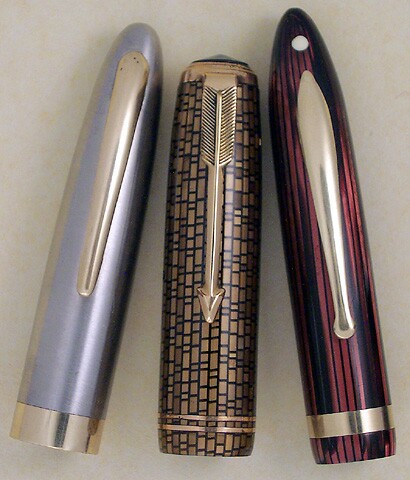PenInHand - Musings on the Hobby
Parker Vacumatic vs. Sheaffer Vacuum-Filler: Sheaffer Wins
by Jim Mamoulides, June 30, 2003

Sheaffer Balance 875 Red Stripe Vacuum-Filler c1937-1939
(Top)
Parker Golden Web Vacumatic 1936-1937 (Bottom)
It's the mid 1930s and the two giants of pendom have squared off, each with its own "sacless" pen, and each heralding it as a revolutionary development. Advertisements for both Parker and Sheaffer first declared their new filling systems as a breakthrough design and pitched numerous advanced features with the new pens. Quickly, as competition picked up, each began to aim more at their principal competitor, with more pointed, direct put-downs appearing in advertisements and dealer literature.
Clash Of Revolutionary Ideas

Parker Azure Blue
Vacumatic Major 1942-1948
Parker advertisements proclaimed the new Vacumatic as "The only pen of its kind!" with an "ever visible ink supply" holding "102% more ink without increase in size." One of Parker's more memorable advertisements was done as a "Ripley's Believe It Or Not!" cartoon, and explicitly states that the pen is "sacless" and that the design "Eliminates 14 old-time parts - including the rubber ink sac." The Vacumatic was offered with a nib that "writes 2 ways", with the normal side writing fine, medium or broad, and the reverse side writing fine or hairline, having an iridium tip on both sides.
With Sheaffer offering many of the same features using a very different filling system, Parker began to take direct shots. "Don't confuse this sacless marvel with ordinary ink sac pens, or with so-called vacuum fillers having squirt-gun piston pumps and valves." Parker took the technological superiority approach, stating a University of Wisconsin scientist invented the Vacumatic and that all other pens are essentially "old-fashioned."
Just The Facts, Ma'am
Of course, Sheaffer could not leave this unchallenged, releasing "Fountain Pen Selling Facts" as a guidebook for retail salespeople at Sheaffer dealers. This twelve-page booklet was specifically written to demonstrate, feature-by-feature, the superiority of the Vacuum-Filler pen over the Vacumatic, as well as reinforce Sheaffer Lifetime and Skrip trademark mindshare. Throughout the booklet the message is "know your merchandise", recommend the item that gives "the best service", and "win satisfied customers".
This booklet is a textbook on classic feature-by-feature comparison and contrast marketing. A sales person who studied it would know exactly why Sheaffer made the superior product and have the answers to any question comparing the two lines.

Parker Golden Web
Vacumatic 1936-1937
The booklet begins with a page that points out the benefits of knowing the product and selling the best value, which leads to more volume, more profits, better wages, and happier customers. These are statements that could be torn from any current marketing text, but set the stage for the rest of the booklet's tone. In the booklet, Sheaffer will be making the case that its pens are not only superior products, but that it only engages in above board market tactics, as opposed to "Brand X". This page also reminds the retailer that while competitors have offered a variety of guarantees on their pens, only Sheaffer has consistently offered a lifetime guarantee on its Lifetime White Dot pens that includes "accidental damage, as well as failure of performance from any other cause except willful abuse or loss."
Sacless vs. Diaphragm
The hard case is really made on pages four and five: "Sheaffer's One-Stroke Sacless Pen Compared With Multiple Stroke Diaphragm Pen." On these pages, Sheaffer uses a classic feature by feature comparison, along with detailed and numbered technical diagrams of the Vacuum-Filler and Vacumatic pens.
Eight points are laid out side by side on the two pages, so the reader can easily compare:
-
Sheaffer: "NO SAC"
Parker: "Widely advertised as a 'sacless' pen, this pen HAS A SAC. The 'diaphragm' is an inverted sac." -
Sheaffer: Will last "indefinitely" as "...only ONE STROKE is needed to empty and fill."
Parker: The sac is "subjected to many times the wear" and is "rolled INSIDE OUT 6 or more times in filling" and more when emptying. -
Sheaffer: "...thoroughly flushed" with every fill.
Parker: "...CANNOT BE THOROUGHLY CLEANED unless taken apart by an expert," -
Sheaffer: The barrel has "permanent visibility" as the plunger wipes the inside of the barrel with each fill.
Parker: Becomes "dim as residues and stains" from ink coat the inside of the barrel, as the pen can't wipe itself clean. -
Sheaffer: The filler has no inherent created weaknesses.
Parker: Because the sac is folded the design creates a point of failure at the fold. -
Sheaffer: "There are NO SPRINGS in this pen."
Parker: "The plunger depends on a spring to operate. A spring can fail by breaking or losing its tension." -
Sheaffer: Operates on a single stroke, making it "a time saver".
Parker: Takes "6 or more" strokes to fill and even more to empty. -
Sheaffer: The blind cap is permanently attached and can't get lost.
Parker: The blind cap is removed to operate, making it something to get lost.
The language on these pages is quite strong, accusing Parker (obliquely and without using the name) of making "misleading statements" and giving the customer "a wrong impression" that the Vacumatic is indeed a "sacless" pen and that sacs break. "So many misleading statements have been published in favor of the latter type that we have taken both types apart to show you what goes on inside them. In contrast, Sheaffer repeatedly emphasizes that its advertising has been honest, correct, and not misleading.
But Wait, There's More
If the filling system argument wasn't enough, Sheaffer spends the next two pages on the merits of the Feathertouch nib, as compared to the "other type of gold and platinum point." The basic argument is that Sheaffer uses platinum plating in the slit of the nib as a "lubricant" which improves the ink flow and "greases" the "ridges" caused from cutting the slit by "smoothing" the path for the ink. Sheaffer claimed that this platinum plating actually "speeds the flow of writing fluid" down the slit to the tip of the nib. The platinum also makes two-way writing more effective by also providing the same lubricating properties when the nib is inverted.

(Left To Right)
Sheaffer Feathertouch / Parker Arrow / Sheaffer Triumph
Nibs
Parker's platinum masking on the nib, therefore, is mere decoration. It's a reverse pattern, with the masking literally outlining the slit. Eversharp also made some platinum masked nibs in the late 1930s and early 1940s and, like Parker, reversed the plating. Interestingly, Parker did make some platinum plated nibs earlier in the 1930s with a very similar design to Sheaffer's Feathertouch and promptly got sued by Sheaffer. Parker ceased manufacture, and these nibs are quite rare.
In addition, Sheaffer spent additional time on its patented "Safety" feed. This design regulates ink flow "controlled to the heart pierce so that it does not flow too freely." At the slit, the platinum plating takes over and "speeds the flow to the writing point." Sheaffer claimed that Parker's feed design has a channel running the length of the nib, "in contact with the point to the full distance," effectively negating any benefit plating the slit would achieve.
Reality TV
With all that's at stake, these claims need to be proved or disproved. A side-by-side test is clearly called for.
Having a few Vacuum-Fillers and Vacumatics visiting for a few days made this the perfect opportunity. I picked examples from the 1930s and 1940s, just to make it interesting. Representing Sheaffer, a 1930s red stripe Balance 875 and a 1940s green stripe Triumph Sentinel 1500. In the Parker corner, a 1930s Golden Web Vacumatic and a 1940s Azure Blue Vacumatic Major.

(Left To Right)
Sheaffer Triumph Sentinel / Parker Golden Web / Sheaffer
Balance Caps
Point by point I reviewed the pens, and considered the actual service history I've experienced.
Regardless of Sheaffer's and Parker's claims for longevity, both pens generally need servicing if found unrestored in the wild. Both are advanced restorations, but the Vacuum-Filler is an expert job, and many are poorly restored, giving the pen an undeserved reputation. Fully serviced, they both work as advertised. I personally don't see any real difference in longevity or advantage of either in general use. So on the first two points, I'd frankly call it a tie.
As to flushing, it's amazing how thorough a well serviced Vacuum-Filler fills and flushes, and how low the effort is. A very modest thrust of the plunger and most will fill 75% or better. Vacumatics just don't empty completely and they are prone to staining. Advantage to Sheaffer on points three and four.
Springs and sacs are a weak spot on Vacumatics. I've had a few that were in trouble, especially the lock down and Speedline fillers. This is a particularly problematic repair. On the other hand, I've had a number of Vacuum-Fillers with stripped and loose end caps. The Vacuum-Filler is a more difficult restoration. Slight advantage to the Vacuum-Filler.
Single stroke filling? Advantage Vacuum-Filler. No question.

Sheaffer Triumph
Sentinel 1500 Vacuum-Filler c1945-1946
Lost blind caps? Does happen, but a minor point. Slight advantage to the Vacuum-Filler.
What about that platinum plated slit? I frankly can't tell any difference at all. Both pens can be set up to write wonderfully. I've heard a lot of debate that Sheaffer's claim is ephemeral science at best, and blatant marketing at worst. I agree that the truth may be a wee bit stretched here.
So who wins? On points? The Sheaffer Vacuum-Filler, but you probably guessed that coming in. In practice, if you like pumping and pumping and pumping and pumping, and horizontal stripes grab your fancy, you'd probably vote for the Vacumatic anyway.
Vive la Difference!
Discuss / Recommend what you read on PenHero.com
Follow us on Twitter: PenHero
Add a link to PenHero.com on your blog:
(Copy & paste code)
Please only use the photo provided. Use of other photos requires permission.
The provided link photo will change as we update the site.
Comments on this article may be sent
to the author, Jim Mamoulides
PenHero.com Bibliography
